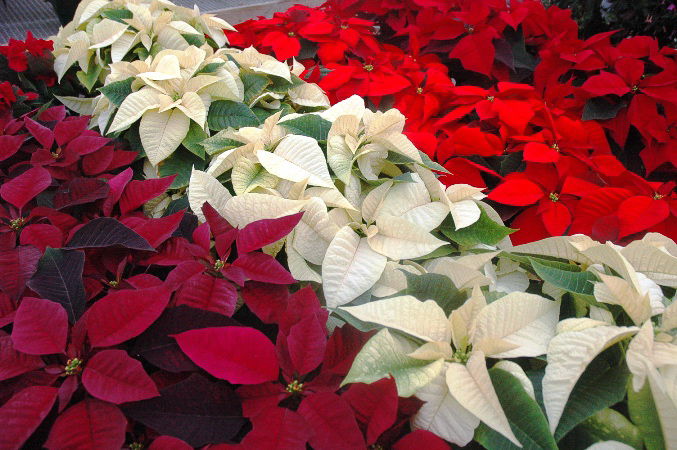Extending the Life of Holiday Plants
Poinsettia (Euphorbia pulcherrima):
Think moderation. Your poinsettia prefers moderately bright light, not direct sunlight. It will tolerate low light. Moderately moist soil is preferred. Water thoroughly when the soil surface feels dry to the touch. Drain the excess water in the saucer under the pot to prevent root rot. Moderate temperatures are ideal: 65-70 degrees during the day and 60-65 at night. Avoid excessively hot or cold drafts, hot radiators and heat ducts.
Do you want your poinsettia to reflower next Christmas? By February, the color usually fades. Keep the plant near a sunny window and fertiilize when new growth appears. Cut the stems back to about 8 inches. On June 1, repot if necessary. Fertilize according to manufacturer's directions and continue to water when the soil is dry to the touch. Move the plant outside if the temperatures do not fall below 50 degrees. Place it in light shade. In late August, take the plant inside. Cut the stems back, leaving 3 to 4 leaves per shoot. Place the plant near a sunny window and water and fertilize as needed. From Sept. 20 to Dec. 1, keep the plant in light only from 8 a.m. to 5 p.m. Put it in the dark, with no lights, from 5 p.m. to 8 a.m. daily. It should rebloom by Dec. 1.
Cyclamen (Cyclamen persicum):
Here's another plant that likes moderation. Moderately bright light or diffused sunlight, such as a curtain-filtered southern or western exposure, is best. Moderately moist soil is preferred. Water thoroughly when the soil surface feels dry to the touch. Drain excess water from the saucer at the base of the pot. Daytime temperatures can range from 60 to 70 degrees. Avoid excessively hot or cold areas. Fertilize periodically.
To reflower a cyclamen, allow it to go completely dormant after flowering. Put it in a cool spot after the foliage dies back and let the soil dry. Slowly stop watering at that time and let the plant rest for two to three months over the summer, watering only to keep the corm from dehydrating and shriveling. Repot the plant in midsummer with new soil. As the first signs of new growth begin, slowly start to increase watering until the normal watering procedure is resumed. Make sure plants have adequate light at all times during growth or poor results can be expected. As the plant grows, gradually return it to a cool location (55 degress) to induce blooming.
Christmas Cactus (Schlumbergera truncata):
Moderately bright light (diffused sunlight) is preferred, near a sunny window but not exposed to direct sun. Moderately moist soil is best. Water thoroughly when the soil surface is dry to the touch. Fertilize periodically, following manufacturer's directions. Cool/moderate temperatures are ideal: 60-70 degrees in the daytime and 55-65 at night. They keep their blossoms longer in cooler temperatures.
Pruning after blooming will encourage the plant to branch out. Pinch off sections with your fingers or cut with a sharp knife. Plants can be moved outdoors in the summer, but keep them in a shady or semi-shady location. The leaves may turn a bit red if exposed to excessive light. Bring the plant back inside in the fall, slowly adjusting the plants to life indoors by gradually increasing the number of hours spent indoors each day. Around mid-October, place the plants in a dark closet from about 8 p.m. to 8 a.m. each night for 6 to 8 weeks or until you see buds forming. Or, eliminate the dark treatment by subjecting the plant to cool temperatures of about 50 to 55 degrees.
Amaryllis Bulbs
Once the amaryllis has finished flowering, you can get it to flower again next year. After flowering, cut off the faded flowers and let the leaves continue to grow and develop. To encourage this, provide the plant regularly with water and houseplant fertilizer. In May, you can plant the bulb - pot and all - in a sheltered spot in the garden for the summer. Starting in September, stop watering. In October, trim the foliage from the bulb and place the bulb - pot and all - in a dry, cool, frost-free location. In January, repot the bulb in fresh potting soil after having removed the old roots. You should then have another flowering in March. (This display will not be as glorious as the first, however, because newly purchased bulbs have just completed a three-year schedule of special care.)




